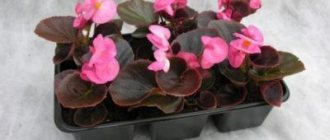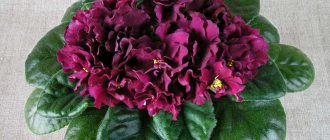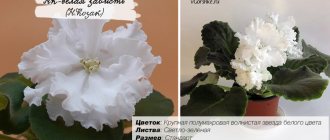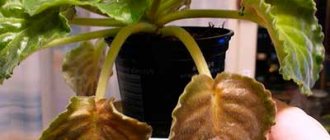General description of the plant
Violet "Optimara" is not a specific variety of plant, but the name of a company that grows Saintpaulia (the second name for violets). The varieties developed by the company usually have the prefix Optimara in their name. Optimara violets are prominent representatives of tropical plants.
The slightest cold can harm them and stop flowering. The roots need warmth; only under this condition will the plant bloom.
These varieties of violets are not viable, which affects their distribution. African violets are not suitable for propagation or distribution . But depending on care, they can produce excellent cuttings, thereby extending their life. Optimara violets are sold in small pots and used as a one-time bouquet, since the buds appear only once.
After the plant fades, it is disposed of. Among the huge variety of types of Optimara violets, one can find similarities in appearance.
All Saintpaulias have rapid growth from cuttings to the appearance of a flowering rosette . Flowers bloom at the same time. The number of flowers during the flowering period is very large. The sockets themselves are small.
Violets are intended for industrial cultivation and are therefore very transportable and unpretentious. The flowers of the plant can have different shades, but they all have a rich color. The flowers of Optimara violets are symmetrical.
Saintpaulias have an underdeveloped fibrous root system . The stems of this violet are fleshy with basal leaves. The leaf has different shapes, depending on the variety it can be round, ovoid, oblong and with a heart-shaped or simple base.
The end of the leaf may have a sharp or rounded tip. There may be small or large teeth along the edges; there are also edges with no relief, slightly rounded.
The leaf of the Optimara violet can be flat, slightly wavy, strongly corrugated, or resemble the shape of a spoon, or a back-curved spoon. Almost always, Saintpaulia leaves are colored in various tones of green, but there is an exception; in some types of violets, the leaf may have areas colored cream, olive, light green, yellow or pink.
Multi-colored areas can be located at the base, along the edges of the leaf blade, or form various mosaic patterns on its surface. The underside of a violet leaf is usually silvery-green , although some varieties or species of violets often have various shades of red in its color.
The surface of the leaves can be glossy or matte, which is covered to varying degrees with hair. The sheet may have a blistered or "quilted" texture.
Conditions for successful growing at home
The violet should be placed indoors in such a way as to provide optimal conditions for growth:
- light - moderate, possibly bright, but always indirect;
- watering - the soil must be slightly moist, but if it is dry near the roots, this will stimulate flowering;
- air - violet does not tolerate drafts and sudden changes in cold air.
Important! To check if the lighting is correct, place your hand over the violet on a sunny day. If there is no shadow from the hand
—
This is the right lighting.
Location and lighting
Of all the varieties, the most popular are those that tolerate low light levels well. But in most varieties the leaves begin to turn yellow. Therefore, the violet must be placed in such a way as to provide it with bright, but indirect lighting. This can be a west or east window. On southern windows, violets are shaded from the sun with curtains or blinds. The correct luminosity for Saintpaulias is between 10,000 and 12,000 lux.
The intensity of sunlight varies depending on the time of year. In winter, violets can be rearranged to receive more light. Rotate the flower ¼ turn each time you drain the tray to ensure even leaf development. If you do not turn the violet, the leaf rosette will begin to lean towards the light source.
If an artificial light source is installed, make sure the plant receives enough light in the red and blue spectrum. Blue is needed for photosynthesis, and red is needed to support flowering. Set a distance of at least 0.5 m between the plant and the light source. Violets need an 8-hour period of darkness per day to begin flowering. This is enough to activate the flowering hormone.
Air temperature and humidity
Saintpaulia thrives in the same conditions that most people enjoy in terms of temperature, humidity and air composition. If you're comfortable, chances are your violets will be too. The temperature should approach +21°C. Do not allow it to fall below +15°C or rise above +27°C. A slight difference between day and night temperatures does not harm the plant. It is normal for these parameters to fluctuate within 10 degrees. At constant high temperatures, violets' stems and leaves lengthen. Then the leaves begin to dry out and fall off.
Did you know? The petals and stems of violets contain large amounts of vitamin C, which they contain even more than some vegetables.
At temperatures below +15°C, plant growth slows down and the violet may die. A sign of death is hanging limp leaves. Optimal humidity is from 70 to 80%. But since in most apartments the humidity is not higher than 60%, it can be increased by using a tray with wet pebbles. As moisture evaporates, the humidity around the flower will increase. Low humidity prevents flower buds from opening. There should be enough space around each plant to ensure good air circulation. This also prevents the transfer of fungal spores if one of the plants becomes diseased.
When and how did the flower appear?
In 1930, the first violets were grown in the company's greenhouses.
In addition to Saintpaulias, the company was engaged in breeding other plants. Each species took its place in the greenhouses; the African violet, for example, was allocated only 1 square meter. But one day the owner of the company, Herman Holtkamp, decided to change the company’s model and deal only with Saintpaulia. Then active work began on creating new varieties, and already in the mid-twentieth century the company achieved great success. The first commercial variety from Holtkamp's selection (1952) was Sankt Martin . Thus began a large-scale breeding of violets, the company began to develop more and more new varieties of Saintpaulia, and little by little they forced almost all existing plants out of the greenhouses.
In 1961 the company changed its name from Dorrenbach-Holtkamp to Hermann Holtkamp Greenhouses. In 1977, greenhouses for growing Saintpaulia were opened in Nashville, Tennessee, and the Optimara trademark was patented.
How to transplant
Saintpaulia is repotted whenever the plant outgrows its current pot. There is also an opinion that it needs to be replanted once a year after flowering.
Read more about the features of violet transplantation at home.
Transplanting Saintpaulia:
- Select a new pot that is 1/3 larger than the size of the plant's leaves.
- Prepare the soil. This can be peat moss, sand and perlite in equal parts, or Saintpaulia soil from the store.
- Moisten the soil mix with warm water.
- Remove the plant from the previous pot.
- Remove damaged roots.
- Add drainage and some potting mix to the pot.
- Place the plant in the center of the pot.
- Add soil to the sides.
- Water the violet after transplanting.
Video: violet transplantation
Review of individual varieties and their photos
There are many known industrial varieties of Optimara violets . All Saintpaulias presented in production differ significantly from each other in color, shape and size.
The violet blooms with large flowers of various colors. They are usually decorated with a spot of contrasting color. The yellow stamens add charm to this flower. The flower stalks are very strong, each of them forms 5-6 buds .
My love
It has light green leaves. Violet flowers have a white tint. They are decorated with a contrasting inky purple spot. A special feature is that in warm weather the flowers become almost completely inky purple, and only the tips of the petals are white.
And in cool weather, violet forms almost white flowers . And in the center of the flower there remains a small inky purple eye with yellow stamens.
We recommend watching a video about the Optimara violet variety “My love”:
My desire
It has two-tone white flowers with a deep pink center. The foliage is medium green in color. The leaves are slightly toothed and heart-shaped.
Ever precious
It is endowed with white flowers with a red-violet border on the lower three petals and blue on the upper two in combination with a green corrugated border. The violet flowers themselves are simple, semi-double, slightly ruffled . The foliage is green, glossy, frilly, slightly wavy.
May dream
A variety from the my Violet series. It has huge simple cup-shaped flowers that look like stars. And in the center there is a bright blue-violet eye. Flowers grow up to 7 cm. They retain their cup-shaped shape for a long time, then open.
Flowers of 2-4 pieces are on short strong peduncles. The flowering is rich and lasts a long time. The foliage is simple quilted and has a medium green color. The reverse side of the sheet is painted red.
The beautiful, quilted, medium green leaves create a perfect flat, even rosette . This allows large white flowers to look great against its background.
We recommend watching a video about the Optimara violet variety “myDream”:
Michigan
Endowed with flowers of a very delicate light pink color. Its flowering is rich and resembles a hat. The leaves are a beautiful green color. On the reverse side they have a red tint. The socket is standard, compact.
Red cabbage salad
Category: Salads Salads from vegetables, mushrooms, cheese Salads from vegetables
I don’t want to share the recipe with you so much as to remind you once again what riches our products have, and we pass by... Red cabbage is not deservedly unclaimed by us. But this is a storehouse of vitamins, rare vitamins, one might say. Take care of your health and that of your loved ones, cook with this cabbage.
What are the industrial varieties of violets?
For industrial cultivation, varieties of violets are selected that are unpretentious to living conditions, resistant to diseases, and characterized by cap flowering.
These plants form a rosette very quickly and impress with very early and long flowering.
By purchasing this variety at a flower shop, you don’t have to worry about the plant not being able to withstand changes in microclimate. Industrial Saintpaulias are attractive for their resistance and abundance of varieties.
Industrial varieties of violets
Industrial violets are the varieties that are most widely used throughout the world due to their qualities.
They are grown in special nurseries using special technologies for sale to hobbyists and for decorating interior spaces during celebrations.
In European countries, these plants are used as disposable bouquets , and after use they are simply thrown away.
The positive qualities of industrial varieties are:
Industrial violets are easy to care for.
These Saintpaulia varieties have regular, slightly rounded leaves with a slight edge. The leaf color is predominantly green.
Flowers in industrial Saintpaulias are small in size and simple in shape, but there are also corrugated ones. Among industrial violets there are no large flowers, double, variegated, or with ruffles.
The coloring of industrial Saintpaulias is limited to white, pink, blue and two-color contrasting chimera.
Nobody finds out the authorship of these varieties or their name. In fact, each variety has its own author and name, but when grown on an industrial scale this is not significant.
Varieties suitable for beginners
Among the industrial Saintpaulias, the following are especially recommended for a beginner:
Ballet snowcone. This variety, also called Snowflake, looks very elegant. During its flowering, a scattering of small white double flowers appears.
Violet variety Ballet snowcone
Optimara Connecticut. Optimara Connecticut is a violet that can be considered a classic. Quite large purple flowers with a smooth edge are found in many homes.
Troika (Trojka). Troikas are difficult to confuse with other varieties. They are distinguished by double colors. Moreover, it is on three petals that the gradient will be more noticeable than others.
All these varieties tolerate the mistakes and shortcomings of novice gardeners well, so it is recommended to get acquainted with violets at home with them.
Features of cultivation and reproduction
To plant, the leaf is lightly trimmed and air-dried, and then planted in the ground. For quick and abundant formation of roots and leaves, preference is given to a lean mixture - peat and sand in a 1:1 ratio. Small sprouts feed on the mother leaf.
After 4-6 weeks, when young shoots have formed, they need to be planted in individual containers.
The earth mixture should contain a larger number of components in a 1:1:1 ratio:
Each sprout should have its own pot. Ideally, plants should not touch their leaves to each other to avoid diseases. If there is not enough space on the windowsill, Saintpaulia can form a rectangular rosette.
How to “persuade” a plant to bloom again?
It's not easy, but it's possible. The main thing is that the plant completely retains its viability, it simply refuses to bloom. And if you fail to persuade this individual, then you can always do this by growing a new “optimark” from a cutting, full of strength and ready to give color. You need to start immediately after the plant enters your home.
- Treat the plant against insect pests.
- If necessary, if any, cut off the affected buds and leaves.
- Create a quarantine period for the plant by placing the pot in a warm place, eliminating any drafts and creating sufficient lighting.
- Spray and feed Saintpaulia for 30 days.
- Then transfer to another vessel.
- During replanting, it is necessary to carefully inspect the roots for rot. If damage to the root system is noticed, then all affected fragments are removed, and the cut areas are sprinkled with charcoal powder. You should also cut off all buds and flowers, remove yellow and blackened leaves. In this case, the central outlet must not be disturbed.
- If there are stepsons, you can cut them off and root them.
- After this, carry out the Saintpaulia care procedure as usual.
Optimaras do not always take root after transplantation, but if you devote time and effort to caring for them, then the chances of winning are great and after just four months they can give you a new cap of star-flowers.
Dutch selection
In a flower shop, all violets are distinguished by their bright and long-lasting flowering, symmetrical rosette, and resistance to conditions and diseases. These Saintpaulias are grown in greenhouses at an industrial level using the latest technology.
Varieties of Dutch Saintpaulias are often not even indicated, since in special laboratories there is a process of constant invention of new varieties. We're not even talking about authorship.
Violets of Dutch selection are widely represented in flower shops.
They are stuffed to such an extent with various chemical fertilizers and growth hormones that it is almost impossible to achieve similar flowering from them. For this reason, industrial varieties are called disposable bouquets.
A feature of the European mentality is the consumer attitude towards these plants. Saintpaulias are grown as a disposable bouquet that is thrown away after flowering. Manufacturers focus on this.
Dutch industrial violet propagates well by cuttings, but the value of these plants is not very high. Among collectors, only original varieties with good distinctive qualities are in demand.
But for a novice amateur, Dutch varieties are attractive due to their price, unpretentiousness and bright flowering.
Home care
In addition to maintaining an optimal microclimate, Saintpaulia needs to be regularly watered and fertilized, and also monitored for pests. For dense leaf rosettes, periodic thinning is carried out to make room for flowers to appear.
Watering
The frequency of watering depends on the condition of the soil. If the top layer is dry to the touch, then it’s time to water. Saintpaulia should be allowed to dry out completely periodically for best flowering results. Overwatering is detrimental to it. If the roots don't dry out, they can't get the air they also need. Violets are prone to deadly pathogens such as root rot, crown rot and pythium root rot. Excess moisture limits the access of nitrogen to the roots, which becomes the root cause of rot.
The water should be at room temperature, or as close as possible to the air temperature at the time of watering. Too cold, it chills the roots, causing the leaves to curl. It will be nice if watering is carried out using drip irrigation. To do this, pour water into the tray with the flower and leave it for a while. The soil will absorb exactly as much water as the roots need. Remove water from the pan after 30 or 40 minutes.
Important! Never use soft water. It increases the salt content of the soil and changes its acidity, reducing the ability of Saintpaulia to absorb nutrients.
Top dressing
Saintpaulias need special violet fertilizers with a higher dose of phosphorus. It should be 2 times more than other components. You can apply fertilizer immediately after each watering in an amount of ¼ of the usual rate. If the leaves turn pale, then the violet does not have enough nutrients. When choosing fertilizers, make sure they are 100% water soluble. This is important, since violet consumes nutrients only from an aqueous solution.
The role of the main substances in the development of Saintpaulia:
- nitrogen is important for the growth and development of leaves and stems;
- phosphorus helps the growth of healthy roots and plays a vital role in promoting flowering;
- Potassium is necessary for the accumulation and movement of compounds that provide energy to the plant.
Learn about the features of planting and growing violets at home.
Trimming
Pruning is necessary in all cases if you see faded flowers or damaged leaves. Their removal will stimulate the development of the next ones. For varieties distinguished by a dense leaf rosette, periodic thinning is carried out, since flower buds cannot break through to the light due to their density. Damaged leaves and flowers should be removed to prevent the spread of diseases. After removal, measures must be taken to treat Saintpaulia.
Removal technique:
- Wipe the scissors with a solution of equal parts water and bleach to disinfect them.
- Completely cut off any damaged or dry parts of the flower.
- Check the condition daily and remove any leaves you find after the first pruning.
- Be careful not to damage adjacent leaves or the trunk. After trimming, disinfect the scissors again.
Do not trim the next plant with unsterile scissors, as this will spread bacteria.
Top 10 most popular industrial varieties
Raphsody Cora
It has bright white petals with a distinct large indigo spot in the center of each petal. Each petal is corrugated at the edges. The leaves are jagged, fleecy, dark green with an obligatory gloss.
This variety is susceptible to temperature . In the hot season, blue color predominates and becomes very deep. In the cold season, on the contrary, white color dominates.
Ever Precious
It has white flowers with a bright purple or lilac border with a ruffled light green ruffle along the edge of the flower. The leaves are light in color and have jagged edges.
forms a standard rosette very
Despite the simple semi-double flowers, this variety attracts at first sight due to its bright colors. On white pansies, a crimson spot creates a bright contrast. This variety belongs to the mini or small standard variety.
The leaves are simple, green. Flowering is capped, with a long period. Each short peduncle has no more than 3 buds.
Ellen
It has an unusual bright pink color with an orange tint . Pansy-shaped flowers have a small ruffle along the edge. A long flowering period while maintaining bright colors makes this variety attractive.
The leaves are toothed and have a red underside. Size – standard.
Ever Rejoice
Attracts lovers with its beautiful salmon color. The flowers are simple, corrugated, with a light green border that disappears after full opening.
The variety forms a small and compact rosette with corrugated shiny foliage. Characterized by frequent, long-lasting and repeated flowering.
Manitoba
It is distinguished by a large cap of light blue flowers with a small spot of a darker shade in the center. The flower shape is pansy. The leaves are round, pointed, and the underside is red. Peduncles are straight, have at least 7 buds.
Attracts with repeated flowering every 2 months and ease of care.
My Love
One of the most popular varieties. The flower is shaped like a star. The color is white with a large contrasting fuchsia patch in the center. The rosette is small, neat, the leaves are simple, dark. Straight and strong peduncles.
It is distinguished by abundant cap flowering.
Mississippi
Attracts with snow-white flowers with delicate pink edging. The shape of the flower is pansy, with a ruffled ruffle along the edge. The leaves are dark, toothed, and form a neat rosette.
By planting a cutting of this variety, you can get a plant with chimeric colors . This variety is classified as semi-standard.
Glacier
It has white flowers with light blue strokes of the original “wasp” shape. The attractiveness of this variety is added by its very abundant flowering.
On a rosette of even, ideal shape, a beautiful bright cap of white flowers with a blue tint is formed.
IsaBelle
It blooms with real bells of a delicate pink color. This variety can be classified as semi-standard - the size of the rosette does not exceed 20 cm. Small flowers strew the bush with a large dense cap. Peduncles grow from all possible axils; the flowering period is very long.
FAQ
Various types and subspecies of violets give rise to many ambiguities and disputes. Beginning gardeners need to familiarize themselves with the answers to the most popular questions.
Differences between domestic species and others
The entire variety of violets can be divided into three large groups:
- indoor;
- garden (the most popular type is Wittrock violet);
- wild (forest).
Main differences:
- Saintpaulias are capricious and take root only at home;
- domestic violets have larger flowers;
- wild and garden flowers have richer colors than indoor flowers;
- Saintpaulias need to be watered several times more often than those growing outside;
- indoor flowers are prone to constant diseases.
Light-loving plant or not?
Uzambara violet needs bright light, but with shading from the direct burning rays of the sun. In order for graceful flowers to fill the room with beauty and tenderness all year round, it is recommended to use artificial lighting. Can the plant be kept indoors? Using a fluorescent lamp with a power of 40 W, the violet will feel great even on the windowsill.
Important: Lighting must be uniform. If a pot of Saintpaulia is located on a window, then you sometimes need to turn the flower on different sides towards the sunlight.
Decorative leaf plant or not?
Currently, violets are classified as ornamental plants. It is often used to improve various areas.
Viola blooms with pleasure in front gardens and flower beds. But do not forget that there are also wild varieties of violets, such as pansies, which should not be equated with decorative ones.
Viola belongs to the category of perennial plants. Depending on the variety, violet blooms from 2 to 5 years, provided all care recommendations are followed.
Violets of Optimara
What it is?
Optimara is one of the world's largest companies growing Uzambara violets , which has existed for about a hundred years.
In the early 30s of the last century, Hermann Holtkamp, the owner of a greenhouse where various plants were grown, decided that the African violet was a cute plant that had a great future.
He encouraged activity in the breeding of new varieties and 20 years later introduced the world's first industrial variety, Sankt Martin.
History of appearance and distribution
They fascinated him so much that he collected their seeds and sent them to his father, who headed the dendrological society.
He sent the find to his friend Wendland, a biologist. Wendland, in turn, set to work on selection. He developed a number of varieties based on the obtained seed material. Having described the type of plant, giving it scientific characteristics, the biologist named them in honor of the discoverer Saint-Paul. This is how Saintpaulia Uzambara or the familiar violets appeared.
The Optimara trademark has existed for about half a century, but the day of creation of the progenitor company lies behind a century-long statute of limitations. In 1904, M. Dorrenbach in the German city of Isselburg organized a small family business for the selection and cultivation of grain crops, and only in the thirtieth year his son-in-law Holtkamp, a professional gardener, got the idea of \u200b\u200bgrowing Saintpaulia.
It was then that Hermann Holtkamp set and predetermined the fate of the Optimara violets. As a co-owner of the company, Holtkamp had the foresight to believe that global prospects were hidden in this cute African flower. That’s what he called Saintpaulia – plants of the future.
Read also: Planting cucumbers in July
Holtkamp enthusiastically began to implement his intention, but during the war he had to pause and when the work was later resumed, the first successes appeared. By the way, later his grown-up son, Reinhold, entered the family business with no less zeal and made a huge contribution to its development.
The beginning of such a large and long journey of Saintpaulia-Optimara was laid on one square of the square. The first batch of these plants, among other seedlings grown in the greenhouse, occupied just one meter by one meter.
Every year the number of violets in the greenhouses of Optimara increased and gradually these travelers from the Uzambara islands occupied the entire area, displacing all other plants from the greenhouses. The Optimara company has begun successful implementation in a new direction - large-scale production of Saintpaulia. It must be said that with such an increase in the number of violets, the company itself grew, gaining weight and financial capital. The company stated its mission: “To make violets as easy to care for as they are beautiful.”











